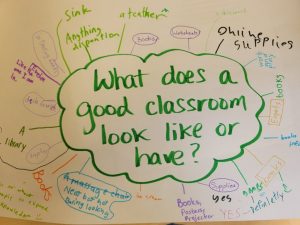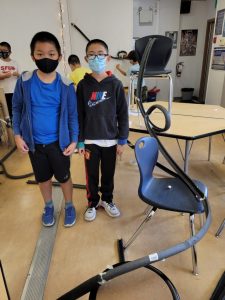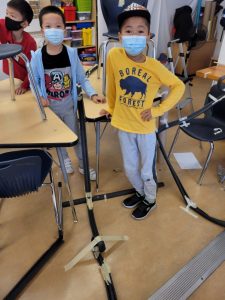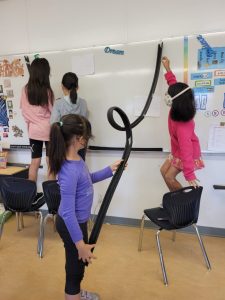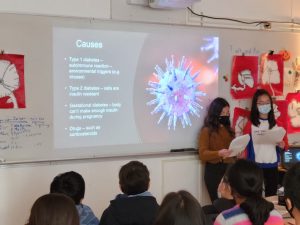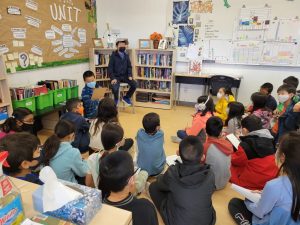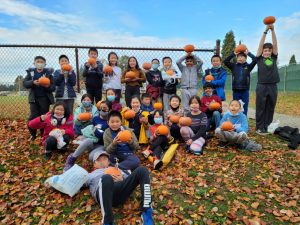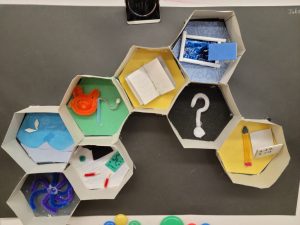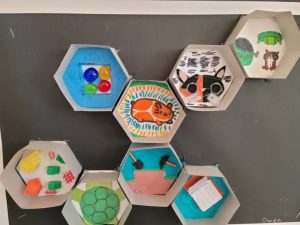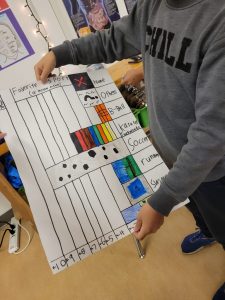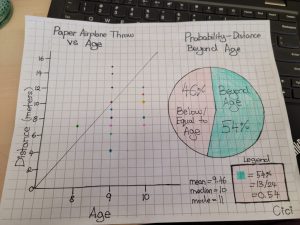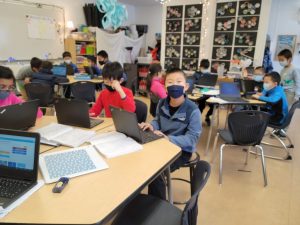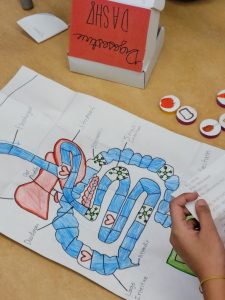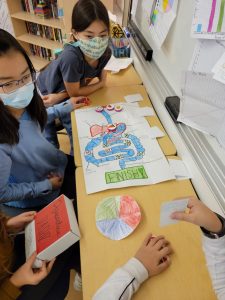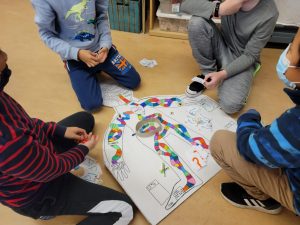Overview from Fall 2021 Term One
Hello Everyone!
As you recall, we had an interim report card for term one in November 2021. That report card covered term one activities from our first unit on SYSTEMS.
On March 10th, you will be receiving a new report card for term two, which is in the full My Education report card format. The term two report card will cover two units, one on CREATIVITY/CHANGE, and the second on EXPLORATION/IDENTITY.
Here is a review of the many things we did during TERM ONE 2021. Stay tuned for a follow up post of what we did during term two!
To tie the big ideas from our curriculum together into a larger, enduring understanding,
we studied all subjects through the lens of a universal, conceptual theme.
For term one we focused on the concept of SYSTEMS
in our unit BODY WORKS.
Unit focus statement:
Our personal choices play a role
in how the interconnected system of the human body works.
Core Competency Focus:
Personal Awareness and Responsibility
Critical Thinking
What is the SYSTEM for a great learning community!
(Core Competencies, Socials, Science, PHE)
We spent the first two weeks creating the foundation of a great learning community! We worked in small teams to design marble roller coasters all over the classroom, discussing both science concepts and what great collaboration looks like during projects.
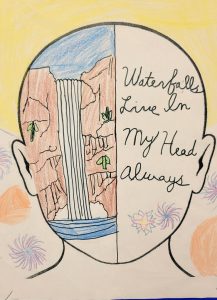 To get to know one another, we also created Six Word Memoir pictures, to communicate some of our interests, strengths, or thoughts to our new classmates. We also did a variety of games, and collaborative math challenges and puzzles. We learned how to have class meetings to voice our preferences, concerns, and ideas about classroom activities.
To get to know one another, we also created Six Word Memoir pictures, to communicate some of our interests, strengths, or thoughts to our new classmates. We also did a variety of games, and collaborative math challenges and puzzles. We learned how to have class meetings to voice our preferences, concerns, and ideas about classroom activities.
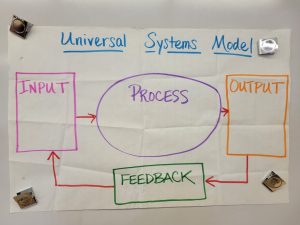 To start our unit, we brainstormed what makes a classroom SYSTEM work well, relating it to the UNIVERSAL SYSTEMS MODEL, an important part of our unit discussions. What do we want to get out of our learning? (output) What do we need to put in to our learning experiences to accomplish our desired output? (input/process)
To start our unit, we brainstormed what makes a classroom SYSTEM work well, relating it to the UNIVERSAL SYSTEMS MODEL, an important part of our unit discussions. What do we want to get out of our learning? (output) What do we need to put in to our learning experiences to accomplish our desired output? (input/process)
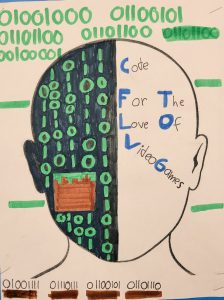 To better understand this, we analyzed other systems we know, such as our community and ecosystems. Then, we identified what our classroom needs to contribute to a successful system. Students brainstormed essential agreements and values, which we refer to every day in our work together.
To better understand this, we analyzed other systems we know, such as our community and ecosystems. Then, we identified what our classroom needs to contribute to a successful system. Students brainstormed essential agreements and values, which we refer to every day in our work together.
Throughout the term, we focused on the core competencies of personal awareness and critical thinking, which were embedded into each activity and lesson for the unit.
THE HUMAN BODY SYSTEMS!
(Science, Socials, Math, Inquiry Processes, LA)
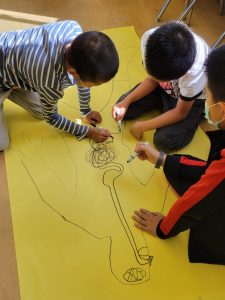 What do you already know about human anatomy? We created life-sized drawings of classmates to identify the inside parts we already knew from our many body systems. We already knew quite a bit, but we needed some more specific information.
What do you already know about human anatomy? We created life-sized drawings of classmates to identify the inside parts we already knew from our many body systems. We already knew quite a bit, but we needed some more specific information.
So, we did independent investigation stations! We gathered facts from non-fiction books and online resources like Kids Health, and completed fun experiments on lung capacity, heart rate, and digestive system length.
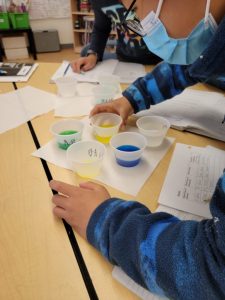 We then pretended the Human Body Corporation was having money problems, needed to make budget cuts, and planned to fire one of the many organs in the body! After learning about paragraphs and business letter format, each student chose an organ to research further and wrote a letter to the Corporation with detailed reasons their organ should not be fired!
We then pretended the Human Body Corporation was having money problems, needed to make budget cuts, and planned to fire one of the many organs in the body! After learning about paragraphs and business letter format, each student chose an organ to research further and wrote a letter to the Corporation with detailed reasons their organ should not be fired!
We did experiments to expand our knowledge of germs and how they are spread, and about how blood typing works! Students learned to use the scientific method, to gather data through careful observations, and to analyze results using math and critical-thinking skills.
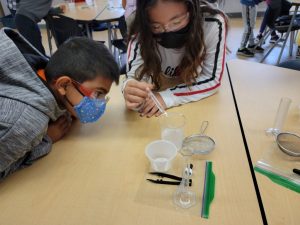 We discussed genetic traits and extracted strawberry DNA, a process which allowed us to learn the role soap plays in bursting the cell membranes of pathogens. Then, we had discussions about herd immunity, vaccines, epistemology (the diagnosis of diseases), and communicable and non-communicable diseases.
We discussed genetic traits and extracted strawberry DNA, a process which allowed us to learn the role soap plays in bursting the cell membranes of pathogens. Then, we had discussions about herd immunity, vaccines, epistemology (the diagnosis of diseases), and communicable and non-communicable diseases.
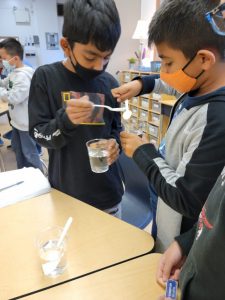 Our lab on “patient zero” allowed us to see how germs are spread quickly in a group! Finally, we tested 24 sites in the school and grew germ colonies in homemade petri dishes. We made careful observations, analyzed our data, and then determined the probability of having touched a bacteria, yeast, mold, or fungus in different locations.
Our lab on “patient zero” allowed us to see how germs are spread quickly in a group! Finally, we tested 24 sites in the school and grew germ colonies in homemade petri dishes. We made careful observations, analyzed our data, and then determined the probability of having touched a bacteria, yeast, mold, or fungus in different locations.
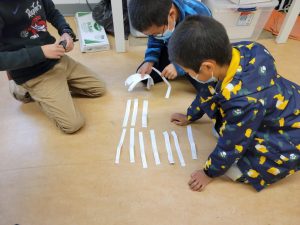 During all experiments, we used critical-thinking to ask questions and make conclusions, and we used personal awareness to work with others collaboratively and safely.
During all experiments, we used critical-thinking to ask questions and make conclusions, and we used personal awareness to work with others collaboratively and safely.
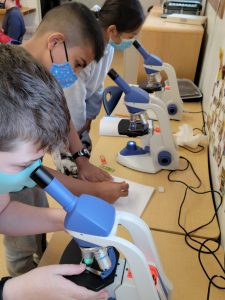 Students also learned how to use advanced microscopes from our secondary schools, as we looked at samples of organ tissue, bacterias, and other small microbes! We became more aware of measurement and scale in terms of just how small a virus or bacteria can be!
Students also learned how to use advanced microscopes from our secondary schools, as we looked at samples of organ tissue, bacterias, and other small microbes! We became more aware of measurement and scale in terms of just how small a virus or bacteria can be!
At the end of the unit, each student chose a disease to investigate further, with the purpose of learning how to take research notes and to find information that would help them diagnose some mystery diseases presented by Ms. D.
SYSTEMS and Applied Design Opportunities!
(ADST, Technology, Math)
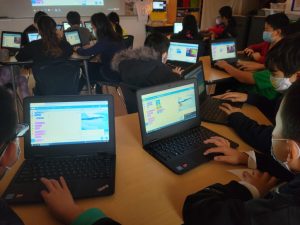 To connect with our unit, we looked at the system of coding and if/then statements used in a program like SCRATCH through Science World’s virtual technology workshops. Each student learned how to do basic coding statements on SCRATCH, and then they created interactive greeting cards around Halloween themes. We continued our work on these after the workshop, and our knowledge of SCRATCH helped us during the December Hour of Code activities.
To connect with our unit, we looked at the system of coding and if/then statements used in a program like SCRATCH through Science World’s virtual technology workshops. Each student learned how to do basic coding statements on SCRATCH, and then they created interactive greeting cards around Halloween themes. We continued our work on these after the workshop, and our knowledge of SCRATCH helped us during the December Hour of Code activities.
What helps the body system work well?
(Socials, Science, PHE-Health, Career Education, Language Arts):
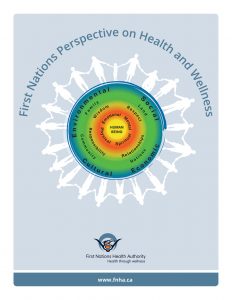 To make our SYSTEM of the human body function effectively, we need to be aware of the INPUTS we put into our body such as food. Students looked at informational graphs, watched TED talks, and listened to a variety of perspectives about good health to learn how to make positive food and environmental choices.
To make our SYSTEM of the human body function effectively, we need to be aware of the INPUTS we put into our body such as food. Students looked at informational graphs, watched TED talks, and listened to a variety of perspectives about good health to learn how to make positive food and environmental choices.
This included exploring the Indigenous Health and Wellness Model to discuss holistic aspects of health, such as the relationship between good health and your connection with family and community.
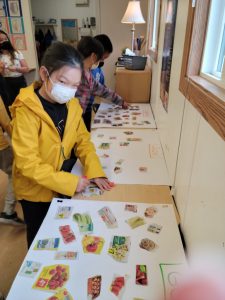 We explored mindful eating, which means having presence while eating and becoming aware of the eating experience. Students brought in snacks and analyzed ingredients lists and food labels to better understand the nutritional value of processed foods. We sorted foods into categories of GO, SLOW, and WHOA to better understand how much of certain foods we can have based on their nutritional content.
We explored mindful eating, which means having presence while eating and becoming aware of the eating experience. Students brought in snacks and analyzed ingredients lists and food labels to better understand the nutritional value of processed foods. We sorted foods into categories of GO, SLOW, and WHOA to better understand how much of certain foods we can have based on their nutritional content.
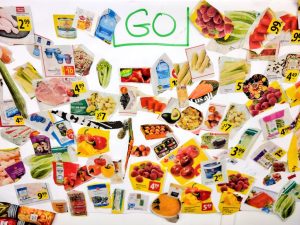 We also studied the impact of vitamins and minerals on the body. Each student chose and conducted research about a vitamin or mineral and its impact on the body. They then created informational posters with facts to share with their classmates.
We also studied the impact of vitamins and minerals on the body. Each student chose and conducted research about a vitamin or mineral and its impact on the body. They then created informational posters with facts to share with their classmates.
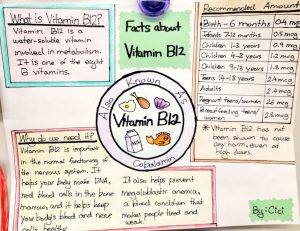 GREEN Vancouver did a virtual trip with us to explain how air quality contributes to our health. We looked at how pollution can contribute to cardiovascular issues, how it impacts the ecosystem we live in, and our role is in reducing that pollution.
GREEN Vancouver did a virtual trip with us to explain how air quality contributes to our health. We looked at how pollution can contribute to cardiovascular issues, how it impacts the ecosystem we live in, and our role is in reducing that pollution.
We played a variety of active games in the gym, and we had discussions about how to monitor your heart rate, as well as the value of daily exercise.
Mental Health & Self-Expression
(Socials/Science/PHE/Career Ed/Art/LA):
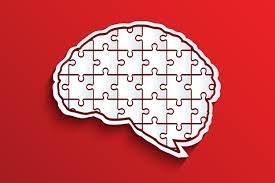 Students explored the connection between our mental health and physical health. We discussed brain structure and how emotion impacts higher thinking, so we can better understand how we self-regulate in times of stress.
Students explored the connection between our mental health and physical health. We discussed brain structure and how emotion impacts higher thinking, so we can better understand how we self-regulate in times of stress.
We learned the function of the main parts, including the amygdala, pre-frontal cortex, and hippocampus. We had great discussion about how it is hard to make rational decisions when one is emotional, so it is important to find self-regulation strategies to calm the brain before taking action.
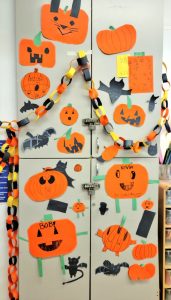 We tried many self-regulation strategies in class, including daily mindful breathing, outdoor breaks, practicing gratitude, taking mindful walks, and using the break board to take a moment during longer work periods.
We tried many self-regulation strategies in class, including daily mindful breathing, outdoor breaks, practicing gratitude, taking mindful walks, and using the break board to take a moment during longer work periods.
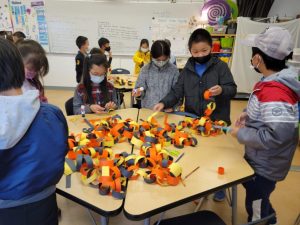 We watched the TED talk “How to Make Stress Your Friend” and discussed how not all stress is bad. We learned that managing stress and being connected with your community contributes to long life.
We watched the TED talk “How to Make Stress Your Friend” and discussed how not all stress is bad. We learned that managing stress and being connected with your community contributes to long life.
Part of mental health is building connections with others. We practiced this in many ways, such as class meetings, free choice times, playing games, organizing classroom decorations for holidays, and doing Suncrest activities together such as the Pumpkin Patch!
How creativity connects with with mental health and personal awareness!
(Fine Arts, Core Competencies, PHE-Health)
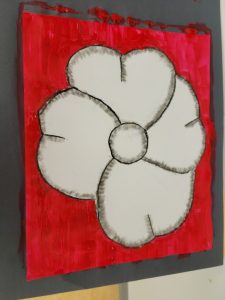 Creativity is an important tool for mental health, and we had many conversations in the classroom about the positive feelings we have when making something!
Creativity is an important tool for mental health, and we had many conversations in the classroom about the positive feelings we have when making something!
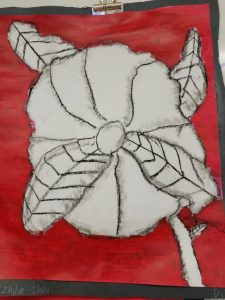 We created beautiful poppy paintings for Remembrance Day, applying elements and principles of art such as colour, emphasis, and negative space.
We created beautiful poppy paintings for Remembrance Day, applying elements and principles of art such as colour, emphasis, and negative space.
We also created HIVE art, using mixed media to represent people, places, and things that bring us strength and help us thrive.
Gathering and Communicating Data
(Math, Language Arts):
We played many probability games, read the entertaining book It’s Possible, discussed the language referring to probability, and through experiments discovered the difference between experimental and theoretical probability. This involved discussion of basic fractions, decimals, and how to find percentages.
We applied this math to our germ lab to express the probability of touching pathogens in locations throughout the school. This is an example of how math knowledge can help us make personal choices that impact our health in positive ways.
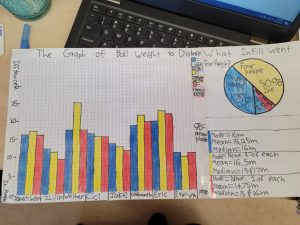 We used the NY Times Learning Network to look at different types of graphs about nutrition, climate change, and blood sugar levels. We practiced two questions to increase our critical thinking and observation skills, “What do you notice?” and “What do you wonder?” We identified essential parts of a graph and how graphs communicate data.
We used the NY Times Learning Network to look at different types of graphs about nutrition, climate change, and blood sugar levels. We practiced two questions to increase our critical thinking and observation skills, “What do you notice?” and “What do you wonder?” We identified essential parts of a graph and how graphs communicate data.
We practiced gathering data, whether about ourselves, genetic traits, or class preferences. We learned to analyze data using measures of central tendency such as mean, median, mode, and range, then applied these skills as we pretended to be consultants analyzing Skittles packages for a fair distribution of colours.
Students ended the unit creating their own graphs about something they could analyze in our classroom or school community.
There are SYSTEMS to communicating, finding, and documenting information! (Language Arts, Socials, Science)
Throughout all subjects, we used language arts curricular competencies to analyze news articles and non-fiction resources, to communicate information in graphics and speeches, and to do research on diseases or nutrition.
We read a variety of articles from Kids Health, learned to take research notes by identifying key ideas, identified criteria for finding appropriate resources online, and discussed ways to better present our ideas in clear, organized, and/or persuasive ways.
We learned about personal and business letter formats, and we discussed how to make a strong, organized paragraph. We strengthened our writing by adding creative vocabulary and looking for ways to express ideas in ways that inspire others.
We talked about what makes an effective speech, and how to be a respectful active listener in the audience. We also discussed how to ask more interesting questions using the inquiry wall prompts, and how to add detail to our e-portfolios to better communicate ideas and our learning.
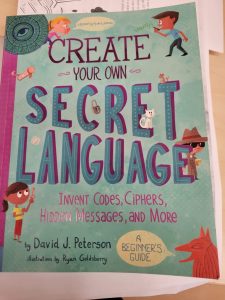 We also looked at the SYSTEM or CODE behind all human languages, and began the process of creating one of our own for fun!
We also looked at the SYSTEM or CODE behind all human languages, and began the process of creating one of our own for fun!
French:
We practiced some basic French with one another using songs, conversation with peers, and games of Simon Says. Students were encouraged to learn some basic vocabulary on parts of the body. Students with French fluency were encouraged to read French articles in magazines we have in the classroom, and to write information about them in their journals.
Putting Learning Together in a Creative Way!
(ADST, Science, Socials, Math, PHE, Language Arts, Core Competencies)
 We ended the term synthesizing our knowledge of SYSTEMS and showing our understanding of how personal choices impact the human body through the creation of a fun game to play with peers.They included questions from all of the subject areas we discussed as part of this unit on SYSTEMS and PERSONAL AWARENESS.
We ended the term synthesizing our knowledge of SYSTEMS and showing our understanding of how personal choices impact the human body through the creation of a fun game to play with peers.They included questions from all of the subject areas we discussed as part of this unit on SYSTEMS and PERSONAL AWARENESS.
Students had a lot of fun using applied design skills to create unique and interactive games!
Overall, it was an amazing term! Students completed self-reflections and made goals for term two!

